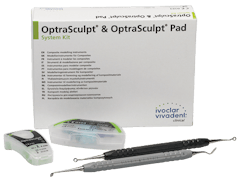PrepSure crown prep instruments by ContacEZ
Nothing sets a restoration up for failure more than underreduction. We are trained to be conservative before anything else, so I understand the intentions involved in underpreparing. If we are going to cut away tooth structure, we need a compelling reason. But underpreparing a tooth for an indirect restoration is not being conservative—it is being overly aggressive.
It may seem weird to think that not cutting tooth structure is being aggressive, but a thin indirect restoration is significantly more likely to fail early versus a restoration with adequate thickness. In addition, adequate reduction gives our ceramists the ability to make the best and most esthetic restoration possible. Let’s be conservative and thoughtful dentists, and let’s set our ceramists and patients up for success.
Unfortunately, most dentists measure reduction by eyeballing it. Until we have Terminator-like prosthetic eyes that give us the ability to measure with our sight, we probably need something better. There are plenty of products on the market made to help with this. I think the key is actually using something for measurement, not about any particular product. With that said, there is one product that works better for me than any of the others. The ContacEZ PrepSure crown prep instrument is the most convenient option, in my opinion.
I have talked about my love for the ContacEZ company before. Started by a dentist, Daniel S. Kim, DDS, and run by his family, ContacEZ is a great small company to work with. It isn’t a faceless conglomerate—it’s a dental company run by a dental family.
The PrepSure kit comes with three different crown prep instruments. The yellow instrument is 1 mm thick. The red PrepSure instrument is 1.5 mm thick, and the blue is 2 mm thick. Each instrument has two sides, one for the mesial and one for the distal. The angles are designed to make it easy to check the mesial or distal half of the preparation with that side of the instrument. The sides are marked, so it’s easy to tell with a quick glance which end is which.
Using the PrepSure instruments is simple. When you think you are done preparing, have the patient bite down. Pick your PrepSure instrument based on the material you plan to use. It’s always a good idea to check with your lab and the material manufacturer to see what the different preparation requirements are. Sometimes the printed guidelines are surprising!
Once you know how much reduction you need, pick up the appropriate PrepSure instrument, and pass the side marked M over the mesial marginal ridge area. If the instrument can be pushed through, you have reduced enough. If not, reduce more of the tooth structure until you can pass the instrument through. Do the same thing on the distal side. Pass the side marked D through the distal marginal ridge and adjust accordingly. The mesial end of the instrument is also good for checking facial and lingual reduction. Trace it around the finish line to see if the tip of the instrument stays within the prep or sits outside of it.
If using these crown prep instruments helps you avoid even one “Doc, you didn’t reduce enough” phone call from your lab, then they are worth their weight in gold. For me, PrepSure instruments are a smash-hit double down the third-base line!
OptraSculpt Next Generation composite contouring instrument by Ivoclar Vivadent
I follow a lot of dental accounts on Instagram. Some of my favorites are the biomimetic dentistry feeds. If you aren’t familiar with the term biomimetic dentistry by now, it basically involves mimicking natural teeth with anatomic restorations. A lot of the biomimetic dentistry I see is visually stunning.
Author's note: If you want to see an example of some of these for yourself, check out the Instagram accounts @bitecamp and @biomimeticstudyclub.
For some reason, folks who are really into biomimetic dentistry are also talented at photography, which results in some pretty spectacular photographs of biomimetic restorations. A lot of these accounts feature direct composite restorations. I have a hard time fully understanding how human beings can produce the anatomy that I see in some of these restorations. I don’t have that ability. I need to cheat to get anywhere near the same results. To me, the OptraSculpt Next Generation composite contouring instrument (Ivoclar Vivadent Inc.) is a tool for cheating pretty sneakily!
I have reviewed the OptraSculpt Pad before, and I still use it all the time for restorations on anterior teeth. The flat surface of the nonstick pad is convenient for shaping composite on flat surfaces, such as those we might encounter on a Class IV restoration. The flat surface on the OptraSculpt Pad is not helpful for most posterior restorations. That's where the OptraSculpt Next Generation composite contouring instrument comes in.
Just like the OptraSculpt Pad, the OptraSculpt Next Generation makes use of nonstick attachments for shaping composite. Instead of just one pad option, this instrument has three—count ’em—three attachments to help you shape composite and add anatomy like a biomimetic pro. The working angle built in to the OptraSculpt Next Generation is perfect for posterior teeth, and it is very easy to use.
The three attachments are a ball, a pointed tip (like a PKT), and a chisel. All of them are nonstick, single-use, and disposable, and the handle is obviously autoclavable. Using these attachments, you can shape inclined planes and fossas, and you can add primary and secondary grooves.
For most restorations, you won’t need all three attachments. One or two will be perfect. From time to time, I use all three on a large restoration. I don’t have a problem using all three if needed, but the attachments add a small disposable fee that I would love to minimize.
Even with the OptraSculpt Next Generation, I can’t compete with some of the direct composite gurus. They are like Da Vinci, and I am like Picasso during the cubist phase. However, with the OptraSculpt Next Generation, I feel like Matisse. Frozen-rope double into the power alley for Ivoclar on the OptraSculpt Next Generation.









